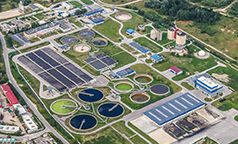pH Wastewater
When carbon dioxide, CO2, is added to an aqueous stream, such as wastewater, carbonic acid (H2CO3) is formed. This acid maintains the pH within the desired range in a safe and effective manner. Corrosive situations are virtually impossible to create due to the self-buffering capabilities of the carbonate/bicarbonate system.
There are a number of benefits that result from the use of carbon dioxide to control pH. The proposed system to adjust and control pH using carbon dioxide will reduce costs, reduce safety hazards, eliminate corrosion, improve pH control, and minimize maintenance.

Tri-State Carbonation Service will install system for your application to adjust and control wastewater pH. Carbon dioxide will be injected in a manner that will provide good gas/liquid mixing for efficient dissolution and sufficient residence time for the hydrolysis of the carbon dioxide. Appropriate instrumentation and controls on the CO2 system will ensure the desired pH level control.
This system can be used for the following industries:
- Textile Mills
- Pulp & Paper Mills
- Chemical Plants
- Food Processing Plants
- Steel Mills
- Electric Generating Stations
- Municipal Potable Water & Waste Water Treatment Plants
Carbon Dioxide Benefits:
Chemical savings can result from the displacement of sulfuric acid. Carbon dioxide is delivered with a 99.9 % purity and can effectively displace 100% of the sulfuric acid currently used to control wastewater pH. For every pound of sulfuric acid that is currently being used less than one pound of carbon dioxide will be required. There is also a purity advantage when using CO2. Carbon dioxide is 99.9 % pure as opposed to sulfuric acid, which is typically 93% pure. Carbon dioxide provides a stable effluent pH due to its characteristic buffering action. In addition to chemical savings and process control, carbon dioxide improves plant safety and reduces corrosion effects caused by acids.
Carbon dioxide is a non-hazardous, non-corrosive compound. Therefore, the risks to operating personnel, equipment, and the environment are minimal. A comparison of OSHA regulations for sulfuric acid and carbon dioxide clearly shows the safety benefits of carbon dioxide. Proper ventilation must be supplied to limit 8-hour exposure to 10,000 PPM for carbon dioxide. This is opposed to acid use, which requires air respirators, eye protection, safety showers and eye wash stations, and protective clothing must be supplied.
Contact the Tri-State Carbonation Service Engineer Team to determine if carbon dioxide is best for your pH control application.
